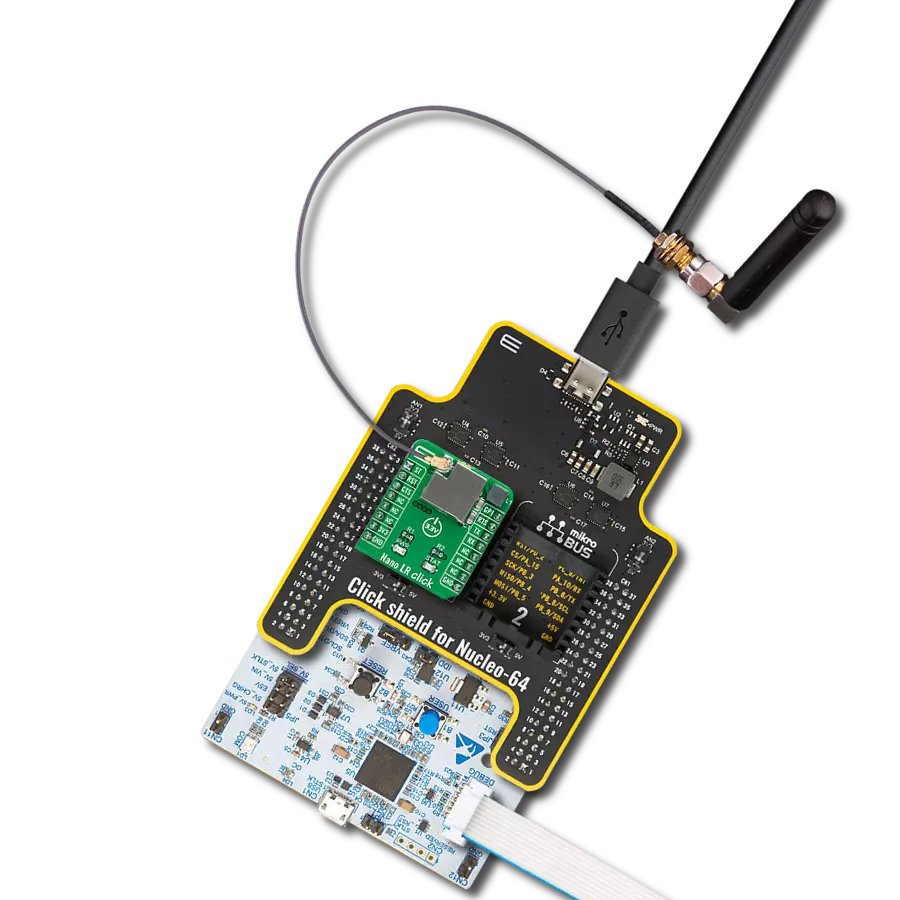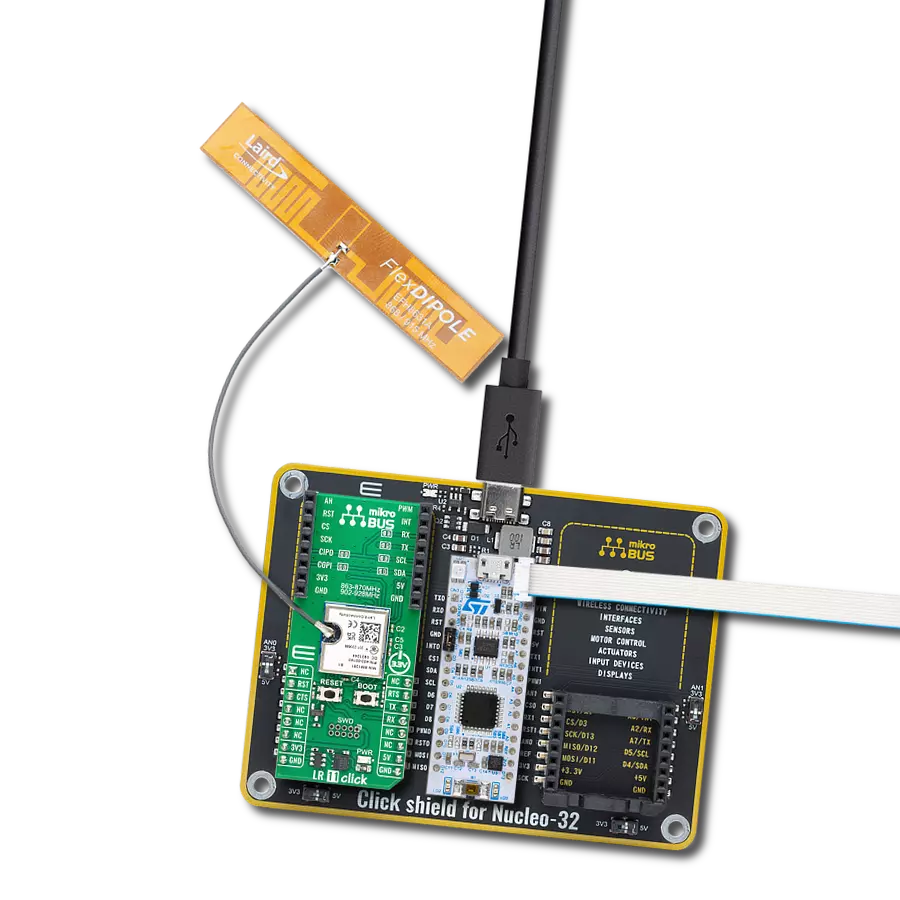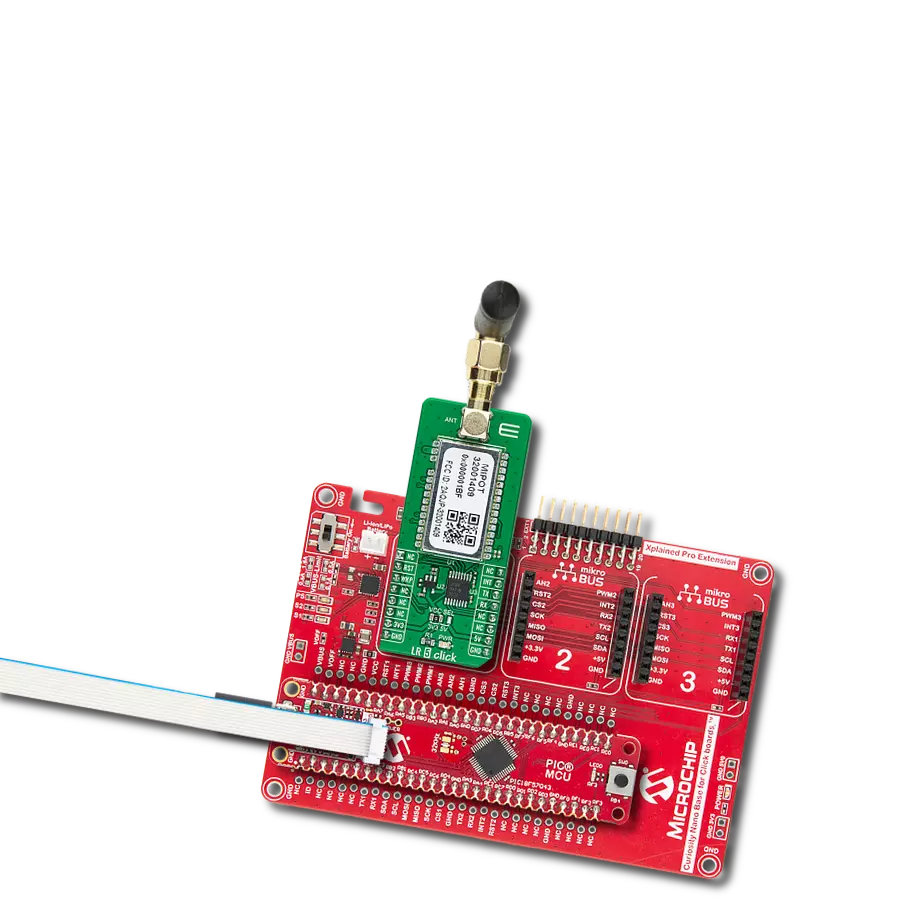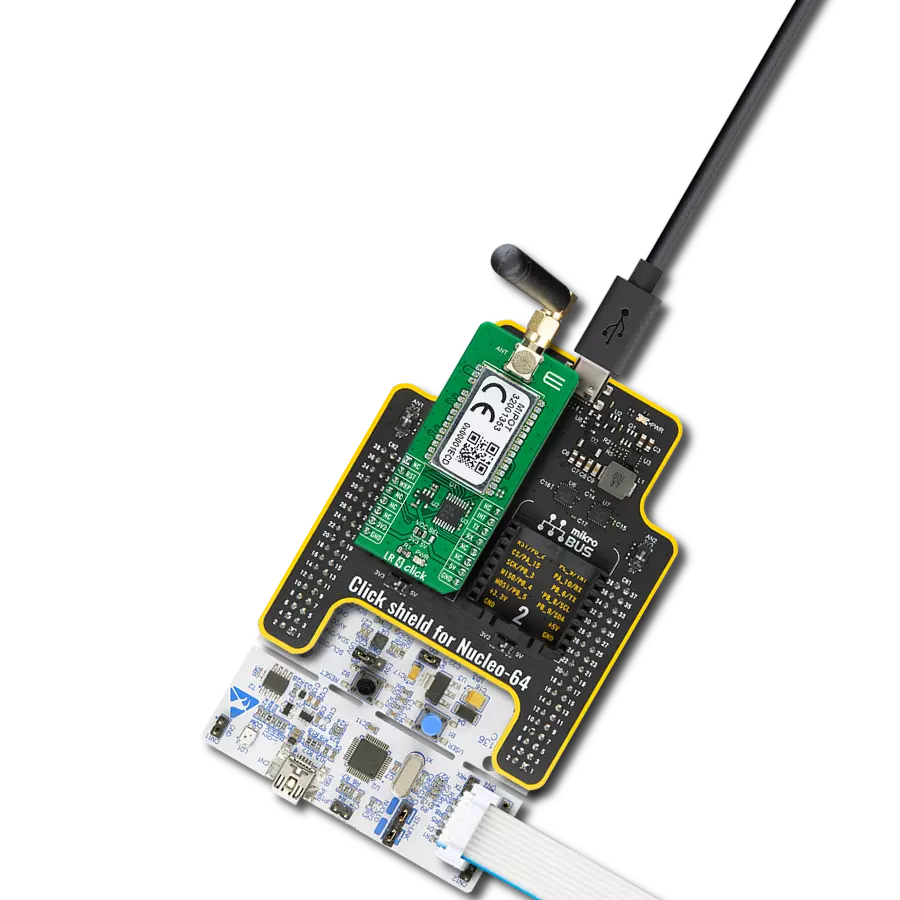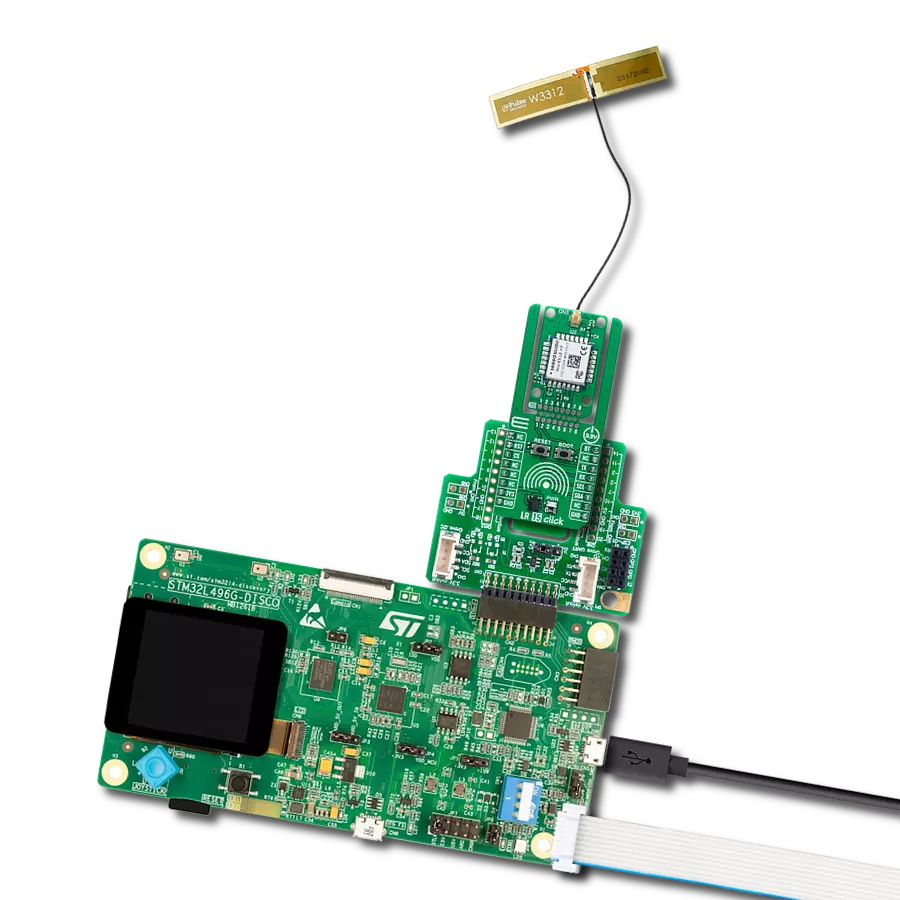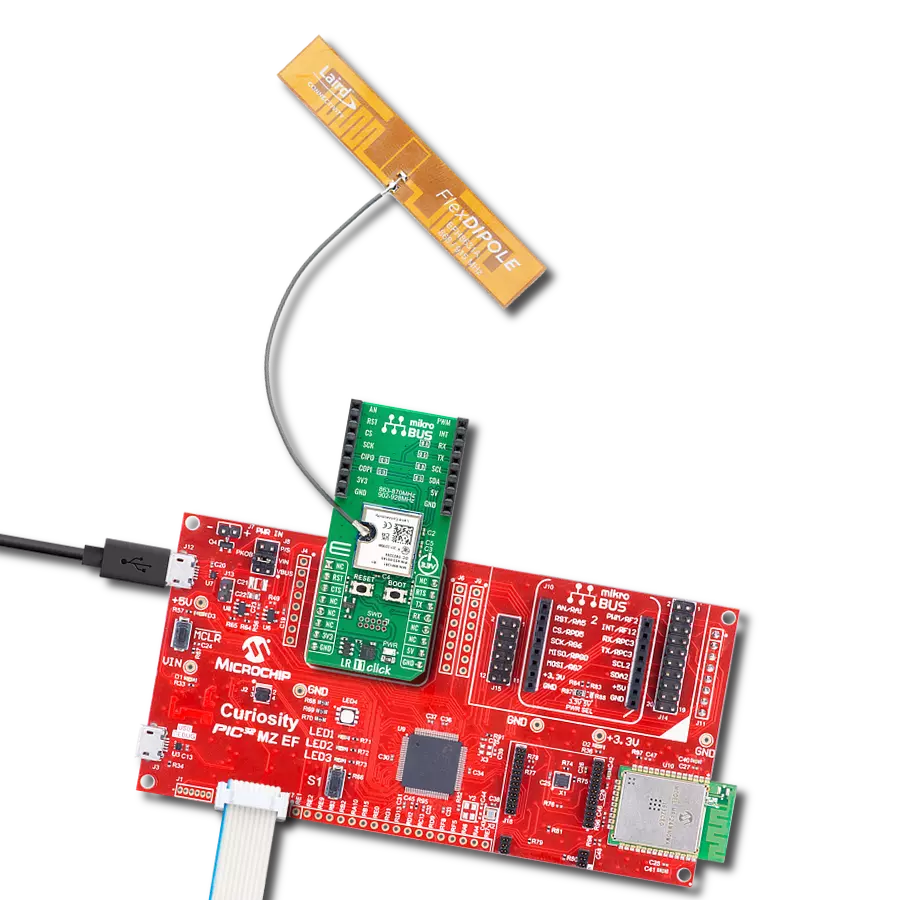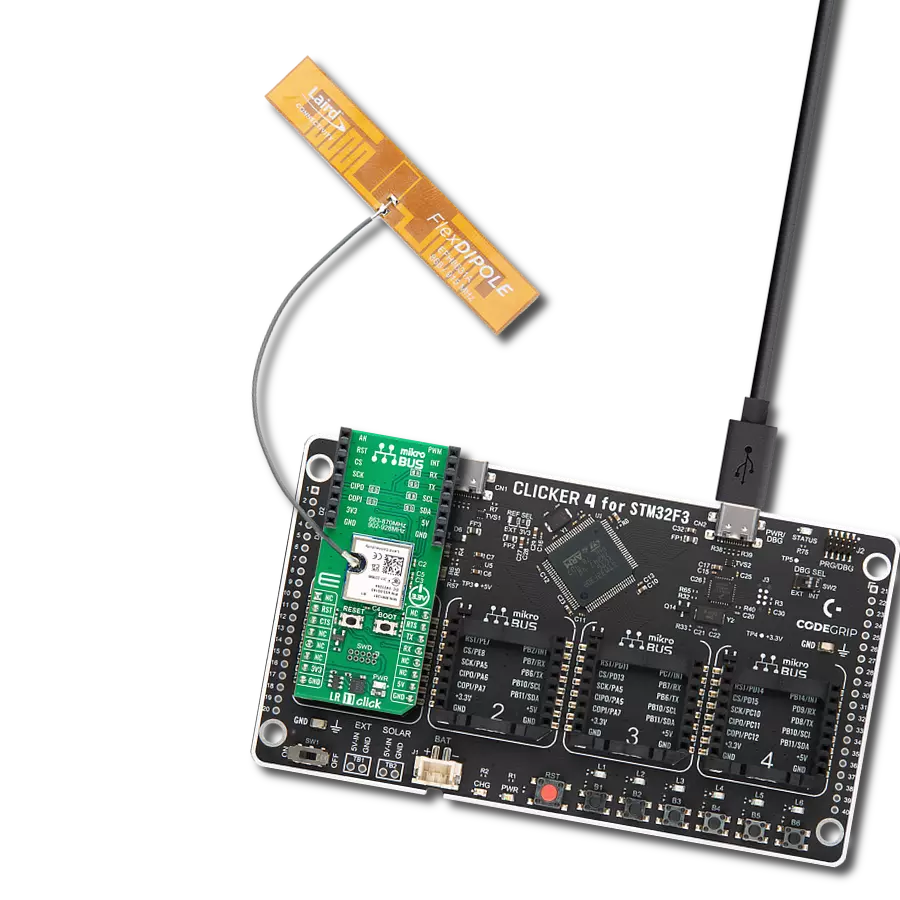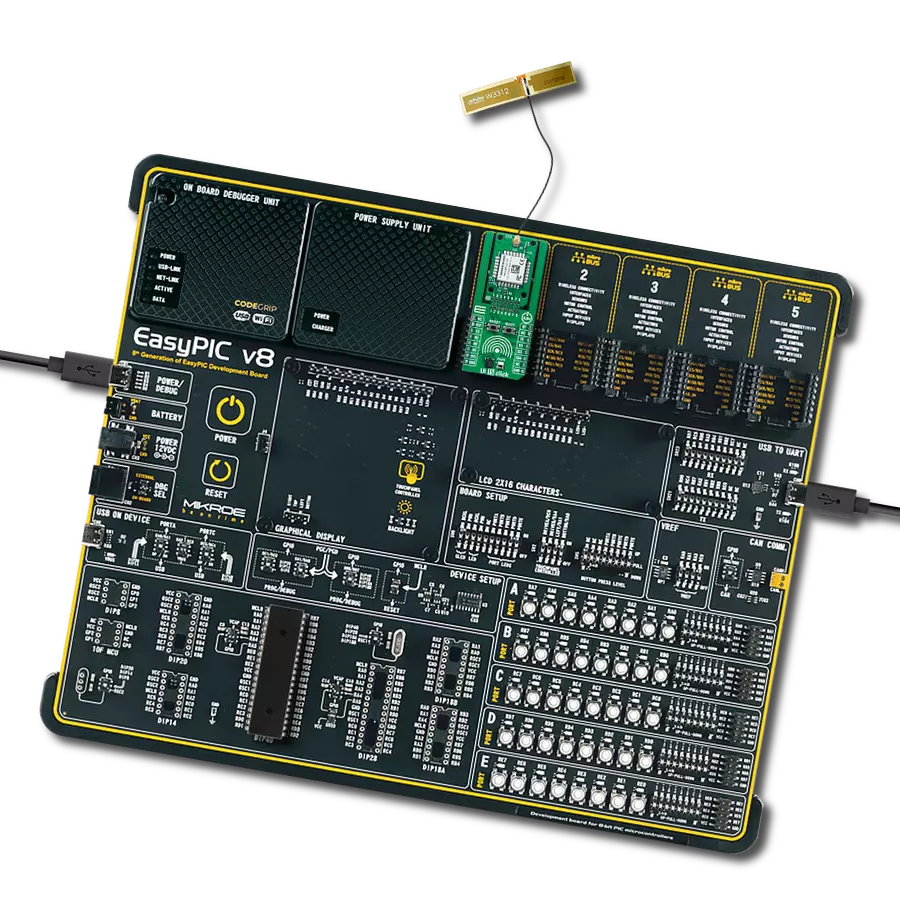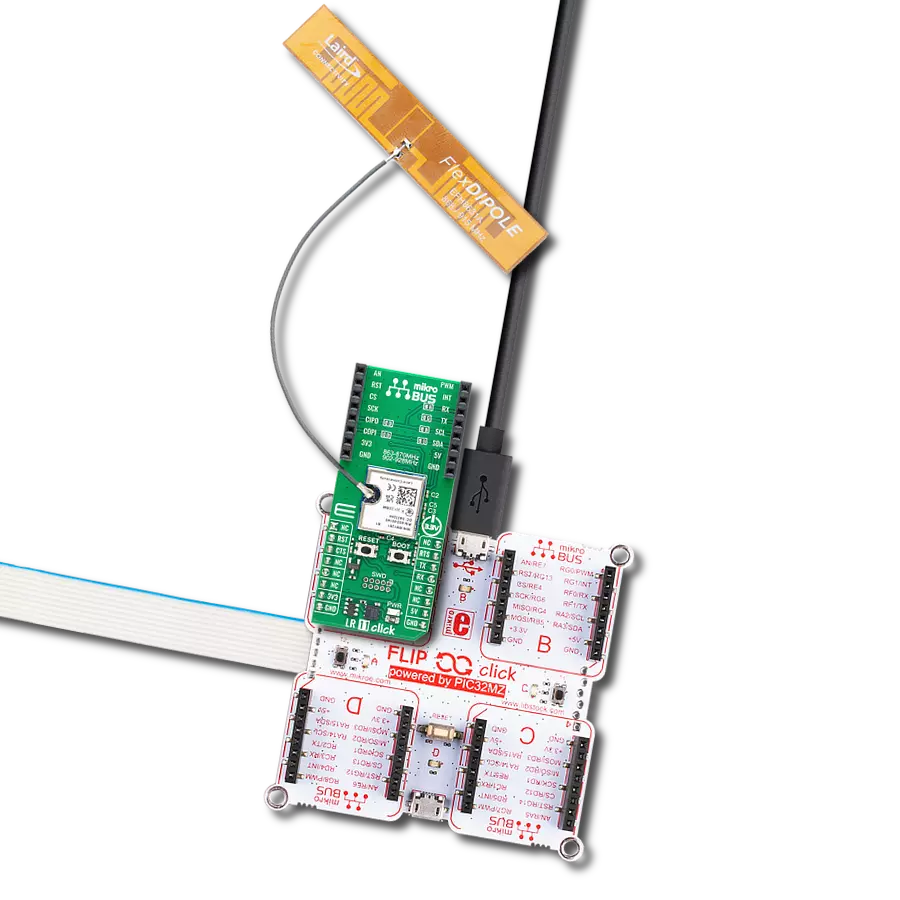Ideal solution for applications requiring reliable 915MHz long-range wide-area communication
A
A
Hardware Overview
How does it work?
LR 11 Click - 915MHz is based on the 453-00139R, an ultra-low power LoRaWAN module from Ezurio. This module is part of the Ezurio RM126x series, specifically the RM1262, which integrates the Silicon Labs EFR32 series System on Chip (SoC) and the Semtech SX1262 radio. This combination provides an efficient, low-power, long-range solution for developing a wide range of LoRaWAN™ applications certified by the LoRa Alliance. The module has a built-in MHF4 connector, a Temperature Compensated Crystal Oscillator (TCXO), and a DC-DC converter, ensuring reliable performance in various environments. Supporting LoRaWAN classes A, B, and C, the 453-00139R offers secure, scalable, and bi-directional communication. It has broad regulatory region support, including USA, Canada, Australia, and New Zealand, and holds certifications such as EU, UKCA, NCC, MIC, and IN, making it a reliable and efficient solution for diverse use cases requiring robust long-range communication. In addition to LoRaWAN capabilities, the 453-00139R features a LoRa Point-to-Point (LoRa P2P) capability, enabling the creation of private, ultra-long-range radio networks between two RM126x modules. This capability supports both unicast and broadcast modes, accommodating up to 64 devices per network. This module is designed to operate in both hosted and hostless modes. In hosted mode, it is programmed with an AT command set, while in hostless mode, it
uses its in-module Cortex-M33 core, which includes 512kB of flash memory and 32kB of RAM. The module's key characteristics also include a frequency range of 902-928MHz, with 915MHz being typical, a maximum transmit power of up to 22dBm, and a communication range of up to 15km in open spaces. This Click board™ is ideal for IoT devices, asset tracking and control, smart home systems, public or private networks, irrigation and agriculture applications, industrial automation, and any long-range, battery-powered sensor application. The 453-00139R and the host MCU are communicated through a UART interface, using standard UART RX and TX pins and hardware flow control pins (CTS/RTS- Clear to Send/Ready to Send) for efficient data transfer. The module defaults to a communication speed of 115200bps, allowing for data exchange over AT commands. At the lower part of the LR 11 Click, an additional unpopulated header offers full support for debugging and programming capabilities. With this header, users can use a Serial Wire Debug interface for programming and debugging, available through the SWD interface pins (SWDIO, SWCLK, and SWO). Besides interface pins, this Click board™ also has a reset pin/button (RESET) for direct module resetting and a BOOT button used to determine when the bootloader must be executed. Upon reset, the bootloader begins execution. When the BOOT button is pressed, the bootloader executes firmware updates via the UART. When
released, the bootloader stops execution and passes control to the main application firmware. A special feature of the LR 11 Click is the additional mikroBUS™ socket, which expands the board's functionality with peripherals such as sensors and LCDs. Added Click boards™ can communicate with the onboard 453-00139R module through UART, SPI, or I2C interfaces. Given that the 453-00139R GPIOs PD02 and PD03 are shared across multiple signals (can be used for all three interfaces), they must be configured appropriately when selecting the communication mode. This is achieved via six pads located on the peripheral mikroBUS™ socket section, enabling the PD02 and PD03 pins of the module to be set for the desired interface. By default, SPI communication is selected with the CIPO and COPI pins connected. If another interface is needed, it is necessary to cut these traces (disconnect them) and then solder the pads of the desired interface pins (UART or I2C). This Click board™ has both mikroBUS™ power rails needed for the peripheral mikroBUS™ socket but only uses a 3.3V voltage level as a main power supply for the 453-00139R module. The board must perform appropriate logic voltage level conversion before using MCUs with different logic levels. It also comes equipped with a library containing functions and example code that can be used as a reference for further development.
Features overview
Development board
Clicker 2 for Kinetis is a compact starter development board that brings the flexibility of add-on Click boards™ to your favorite microcontroller, making it a perfect starter kit for implementing your ideas. It comes with an onboard 32-bit ARM Cortex-M4F microcontroller, the MK64FN1M0VDC12 from NXP Semiconductors, two mikroBUS™ sockets for Click board™ connectivity, a USB connector, LED indicators, buttons, a JTAG programmer connector, and two 26-pin headers for interfacing with external electronics. Its compact design with clear and easily recognizable silkscreen markings allows you to build gadgets with unique functionalities and
features quickly. Each part of the Clicker 2 for Kinetis development kit contains the components necessary for the most efficient operation of the same board. In addition to the possibility of choosing the Clicker 2 for Kinetis programming method, using a USB HID mikroBootloader or an external mikroProg connector for Kinetis programmer, the Clicker 2 board also includes a clean and regulated power supply module for the development kit. It provides two ways of board-powering; through the USB Micro-B cable, where onboard voltage regulators provide the appropriate voltage levels to each component on the board, or
using a Li-Polymer battery via an onboard battery connector. All communication methods that mikroBUS™ itself supports are on this board, including the well-established mikroBUS™ socket, reset button, and several user-configurable buttons and LED indicators. Clicker 2 for Kinetis is an integral part of the Mikroe ecosystem, allowing you to create a new application in minutes. Natively supported by Mikroe software tools, it covers many aspects of prototyping thanks to a considerable number of different Click boards™ (over a thousand boards), the number of which is growing every day.
Microcontroller Overview
MCU Card / MCU
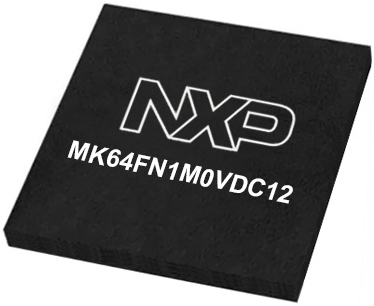
Architecture
ARM Cortex-M4
MCU Memory (KB)
1024
Silicon Vendor
NXP
Pin count
121
RAM (Bytes)
262144
You complete me!
Accessories
The Sub-GHz FlexDIPOLE antenna, specifically the Ezurio 868/915 MHz model, is a compact and highly versatile antenna designed to deliver robust and consistent performance across the entire 868 and 915 MHz ISM bands. Its small footprint, coupled with flexible dipole technology, makes it ideal for demanding applications like LoRaWAN and other sub-GHz technologies. The antenna has MHF4L connector options, ensuring easy integration into various systems. Additionally, its adhesive backing allows for quick and easy installation, providing reliable coverage from 863 to 928 MHz in challenging real-world conditions.

Used MCU Pins
mikroBUS™ mapper
Take a closer look
Click board™ Schematic

Step by step
Project assembly
Track your results in real time
Application Output
1. Application Output - In Debug mode, the 'Application Output' window enables real-time data monitoring, offering direct insight into execution results. Ensure proper data display by configuring the environment correctly using the provided tutorial.

2. UART Terminal - Use the UART Terminal to monitor data transmission via a USB to UART converter, allowing direct communication between the Click board™ and your development system. Configure the baud rate and other serial settings according to your project's requirements to ensure proper functionality. For step-by-step setup instructions, refer to the provided tutorial.

3. Plot Output - The Plot feature offers a powerful way to visualize real-time sensor data, enabling trend analysis, debugging, and comparison of multiple data points. To set it up correctly, follow the provided tutorial, which includes a step-by-step example of using the Plot feature to display Click board™ readings. To use the Plot feature in your code, use the function: plot(*insert_graph_name*, variable_name);. This is a general format, and it is up to the user to replace 'insert_graph_name' with the actual graph name and 'variable_name' with the parameter to be displayed.

Software Support
Library Description
This library contains API for LR 11 Click - 915MHz driver.
Key functions:
lr11915mhz_reset_device- This function resets the device by toggling the reset pin logic state.lr11915mhz_cmd_run- This function sends a specified command with or without parameters to the click module.lr11915mhz_cmd_set- This function sets a value to a specified command parameter of the click module.
Open Source
Code example
The complete application code and a ready-to-use project are available through the NECTO Studio Package Manager for direct installation in the NECTO Studio. The application code can also be found on the MIKROE GitHub account.
/*!
* @file main.c
* @brief LR 11 915MHz Click Example.
*
* # Description
* This example demonstrates the use of LR 11 915MHz Click board by showing
* the communication between two Click boards configured in P2P network mode.
*
* The demo application is composed of two sections :
*
* ## Application Init
* Initializes the driver and logger.
*
* ## Application Task
* Application task is split in few stages:
* - LR11915MHZ_POWER_UP:
* Powers up the device, performs a device factory reset and reads system information.
* - LR11915MHZ_CONFIG_EXAMPLE:
* Configures device for the LoRa P2P network mode.
* - LR11915MHZ_EXAMPLE:
* Performs a LoRa P2P example by exchanging messages with another LR 11 915MHz Click board.
* One device should be set to NODE_0_ADDRESS, and the other to NODE_1_ADDRESS.
*
* ## Additional Function
* - static void lr11915mhz_clear_app_buf ( void )
* - static void lr11915mhz_log_app_buf ( void )
* - static err_t lr11915mhz_process ( lr11915mhz_t *ctx )
* - static err_t lr11915mhz_read_response ( lr11915mhz_t *ctx, uint8_t *rsp )
* - static err_t lr11915mhz_power_up ( lr11915mhz_t *ctx )
* - static err_t lr11915mhz_config_example ( lr11915mhz_t *ctx )
* - static err_t lr11915mhz_example ( lr11915mhz_t *ctx )
*
* @author Stefan Filipovic
*
*/
#include "board.h"
#include "log.h"
#include "lr11915mhz.h"
#include "conversions.h"
#include "generic_pointer.h"
// Node address selection macros
#define NODE_0_ADDRESS 0
#define NODE_1_ADDRESS 1
#define NODE_ADDRESS NODE_0_ADDRESS
// Text message for transmittion
#define DEMO_TEXT_MESSAGE "MIKROE - LR 11 915MHz Click board"
static lr11915mhz_t lr11915mhz;
static log_t logger;
// Application buffer size
#define APP_BUFFER_SIZE 600
#define PROCESS_BUFFER_SIZE 200
static uint8_t app_buf[ APP_BUFFER_SIZE ] = { 0 };
static int32_t app_buf_len = 0;
/**
* @brief Example states.
* @details Predefined enum values for application example state.
*/
typedef enum
{
LR11915MHZ_POWER_UP = 1,
LR11915MHZ_CONFIG_EXAMPLE,
LR11915MHZ_EXAMPLE
} lr11915mhz_app_state_t;
static lr11915mhz_app_state_t app_state = LR11915MHZ_POWER_UP;
/**
* @brief LR 11 915MHz clearing application buffer.
* @details This function clears memory of application buffer and reset its length.
* @note None.
*/
static void lr11915mhz_clear_app_buf ( void );
/**
* @brief LR 11 915MHz log application buffer.
* @details This function logs data from application buffer to USB UART.
* @note None.
*/
static void lr11915mhz_log_app_buf ( void );
/**
* @brief LR 11 915MHz data reading function.
* @details This function reads data from device and concatenates data to application buffer.
* @param[in] ctx : Click context object.
* See #lr11915mhz_t object definition for detailed explanation.
* @return @li @c 0 - Read some data.
* @li @c -1 - Nothing is read.
* See #err_t definition for detailed explanation.
* @note None.
*/
static err_t lr11915mhz_process ( lr11915mhz_t *ctx );
/**
* @brief LR 11 915MHz read response function.
* @details This function waits for a response message, reads and displays it on the USB UART.
* @param[in] ctx : Click context object.
* See #lr11915mhz_t object definition for detailed explanation.
* @param[in] rsp Expected response.
* @return @li @c 0 - OK response.
* @li @c -2 - Timeout error.
* @li @c -3 - Command error.
* See #err_t definition for detailed explanation.
* @note None.
*/
static err_t lr11915mhz_read_response ( lr11915mhz_t *ctx, uint8_t *rsp );
/**
* @brief LR 11 915MHz power up function.
* @details This function powers up the device, performs device factory reset and reads system information.
* @param[in] ctx : Click context object.
* See #lr11915mhz_t object definition for detailed explanation.
* @return @li @c 0 - OK.
* @li @c != 0 - Read response error.
* See #err_t definition for detailed explanation.
* @note None.
*/
static err_t lr11915mhz_power_up ( lr11915mhz_t *ctx );
/**
* @brief LR 11 915MHz config example function.
* @details This function configures device for LoRa P2P example.
* @param[in] ctx : Click context object.
* See #lr11915mhz_t object definition for detailed explanation.
* @return @li @c 0 - OK.
* @li @c != 0 - Read response error.
* See #err_t definition for detailed explanation.
* @note None.
*/
static err_t lr11915mhz_config_example ( lr11915mhz_t *ctx );
/**
* @brief LR 11 915MHz example function.
* @details This function performs a LoRa P2P example by exchanging messages with another LR 11 915MHz Click board.
* @param[in] ctx : Click context object.
* See #lr11915mhz_t object definition for detailed explanation.
* @return @li @c 0 - OK.
* @li @c != 0 - Read response error.
* See #err_t definition for detailed explanation.
* @note None.
*/
static err_t lr11915mhz_example ( lr11915mhz_t *ctx );
void application_init ( void )
{
log_cfg_t log_cfg; /**< Logger config object. */
lr11915mhz_cfg_t lr11915mhz_cfg; /**< Click config object. */
/**
* Logger initialization.
* Default baud rate: 115200
* Default log level: LOG_LEVEL_DEBUG
* @note If USB_UART_RX and USB_UART_TX
* are defined as HAL_PIN_NC, you will
* need to define them manually for log to work.
* See @b LOG_MAP_USB_UART macro definition for detailed explanation.
*/
LOG_MAP_USB_UART( log_cfg );
log_init( &logger, &log_cfg );
log_info( &logger, " Application Init " );
// Click initialization.
lr11915mhz_cfg_setup( &lr11915mhz_cfg );
LR11915MHZ_MAP_MIKROBUS( lr11915mhz_cfg, MIKROBUS_1 );
if ( UART_ERROR == lr11915mhz_init( &lr11915mhz, &lr11915mhz_cfg ) )
{
log_error( &logger, " Communication init." );
for ( ; ; );
}
log_info( &logger, " Application Task " );
app_state = LR11915MHZ_POWER_UP;
log_printf( &logger, ">>> APP STATE - POWER UP <<<\r\n\n" );
}
void application_task ( void )
{
switch ( app_state )
{
case LR11915MHZ_POWER_UP:
{
if ( LR11915MHZ_OK == lr11915mhz_power_up( &lr11915mhz ) )
{
app_state = LR11915MHZ_CONFIG_EXAMPLE;
log_printf( &logger, ">>> APP STATE - CONFIG EXAMPLE <<<\r\n\n" );
}
break;
}
case LR11915MHZ_CONFIG_EXAMPLE:
{
if ( LR11915MHZ_OK == lr11915mhz_config_example( &lr11915mhz ) )
{
app_state = LR11915MHZ_EXAMPLE;
log_printf( &logger, ">>> APP STATE - EXAMPLE <<<\r\n\n" );
}
break;
}
case LR11915MHZ_EXAMPLE:
{
lr11915mhz_example( &lr11915mhz );
break;
}
default:
{
log_error( &logger, " APP STATE." );
break;
}
}
}
int main ( void )
{
/* Do not remove this line or clock might not be set correctly. */
#ifdef PREINIT_SUPPORTED
preinit();
#endif
application_init( );
for ( ; ; )
{
application_task( );
}
return 0;
}
static void lr11915mhz_clear_app_buf ( void )
{
memset( app_buf, 0, app_buf_len );
app_buf_len = 0;
}
static void lr11915mhz_log_app_buf ( void )
{
for ( int32_t buf_cnt = 0; buf_cnt < app_buf_len; buf_cnt++ )
{
log_printf( &logger, "%c", app_buf[ buf_cnt ] );
}
}
static err_t lr11915mhz_process ( lr11915mhz_t *ctx )
{
uint8_t rx_buf[ PROCESS_BUFFER_SIZE ] = { 0 };
int32_t overflow_bytes = 0;
int32_t rx_cnt = 0;
int32_t rx_size = lr11915mhz_generic_read( ctx, rx_buf, PROCESS_BUFFER_SIZE );
if ( ( rx_size > 0 ) && ( rx_size <= APP_BUFFER_SIZE ) )
{
if ( ( app_buf_len + rx_size ) > APP_BUFFER_SIZE )
{
overflow_bytes = ( app_buf_len + rx_size ) - APP_BUFFER_SIZE;
app_buf_len = APP_BUFFER_SIZE - rx_size;
memmove ( app_buf, &app_buf[ overflow_bytes ], app_buf_len );
memset ( &app_buf[ app_buf_len ], 0, overflow_bytes );
}
for ( rx_cnt = 0; rx_cnt < rx_size; rx_cnt++ )
{
if ( rx_buf[ rx_cnt ] )
{
app_buf[ app_buf_len++ ] = rx_buf[ rx_cnt ];
}
}
return LR11915MHZ_OK;
}
return LR11915MHZ_ERROR;
}
static err_t lr11915mhz_read_response ( lr11915mhz_t *ctx, uint8_t *rsp )
{
#define READ_RESPONSE_TIMEOUT_MS 30000
uint32_t timeout_cnt = 0;
lr11915mhz_clear_app_buf ( );
lr11915mhz_process( ctx );
while ( ( 0 == strstr( app_buf, rsp ) ) &&
( 0 == strstr( app_buf, LR11915MHZ_RSP_ERROR ) ) )
{
lr11915mhz_process( ctx );
if ( timeout_cnt++ > READ_RESPONSE_TIMEOUT_MS )
{
lr11915mhz_clear_app_buf( );
log_error( &logger, " Timeout!" );
return LR11915MHZ_ERROR_TIMEOUT;
}
Delay_ms( 1 );
}
Delay_ms ( 200 );
lr11915mhz_process( ctx );
if ( strstr( app_buf, rsp ) )
{
lr11915mhz_log_app_buf( );
log_printf( &logger, "--------------------------------\r\n" );
return LR11915MHZ_OK;
}
lr11915mhz_log_app_buf( );
return LR11915MHZ_ERROR_CMD;
}
static err_t lr11915mhz_power_up ( lr11915mhz_t *ctx )
{
err_t error_flag = LR11915MHZ_OK;
log_printf( &logger, ">>> Reset device.\r\n" );
lr11915mhz_reset_device( &lr11915mhz );
while ( LR11915MHZ_OK == lr11915mhz_process( ctx ) )
{
lr11915mhz_log_app_buf( );
lr11915mhz_clear_app_buf ( );
}
log_printf( &logger, "--------------------------------\r\n" );
log_printf( &logger, ">>> Factory reset.\r\n" );
lr11915mhz_cmd_run( &lr11915mhz, LR11915MHZ_CMD_FACTORY_RESET, NULL );
error_flag |= lr11915mhz_read_response( &lr11915mhz, LR11915MHZ_RSP_OK );
log_printf( &logger, ">>> Check communication.\r\n" );
lr11915mhz_cmd_run( &lr11915mhz, LR11915MHZ_CMD_AT, NULL );
error_flag |= lr11915mhz_read_response( &lr11915mhz, LR11915MHZ_RSP_OK );
log_printf( &logger, ">>> Get device type.\r\n" );
lr11915mhz_cmd_run( ctx, LR11915MHZ_CMD_GET_INFO, LR11915MHZ_PARAM_DEVICE_TYPE );
error_flag |= lr11915mhz_read_response( ctx, LR11915MHZ_RSP_OK );
log_printf( &logger, ">>> Get firmware version.\r\n" );
lr11915mhz_cmd_run( ctx, LR11915MHZ_CMD_GET_INFO, LR11915MHZ_PARAM_APP_FW_VERSION );
error_flag |= lr11915mhz_read_response( ctx, LR11915MHZ_RSP_OK );
return error_flag;
}
static err_t lr11915mhz_config_example ( lr11915mhz_t *ctx )
{
uint8_t data_buf[ 10 ] = { 0 };
err_t error_flag = LR11915MHZ_OK;
#define DEVICE_CLASS_P2P "3"
log_printf( &logger, ">>> Set LoRa operation to P2P.\r\n" );
lr11915mhz_cmd_set( ctx, LR11915MHZ_CMD_PARAM_ACCESS_NUM, LR11915MHZ_PARAM_ID_DEVICE_CLASS, DEVICE_CLASS_P2P );
error_flag |= lr11915mhz_read_response( ctx, LR11915MHZ_RSP_OK );
#define REGION_US902_928 "3"
log_printf( &logger, ">>> Set operation region to US902_928.\r\n" );
lr11915mhz_cmd_set( ctx, LR11915MHZ_CMD_PARAM_ACCESS_NUM, LR11915MHZ_PARAM_ID_REGION, REGION_US902_928 );
error_flag |= lr11915mhz_read_response( ctx, LR11915MHZ_RSP_OK );
int16_to_str ( NODE_ADDRESS, data_buf );
l_trim ( data_buf );
r_trim ( data_buf );
log_printf( &logger, ">>> Set P2P node address to %s.\r\n", data_buf );
lr11915mhz_cmd_set( ctx, LR11915MHZ_CMD_PARAM_ACCESS_NUM, LR11915MHZ_PARAM_ID_P2P_DEVICE_ADDRESS, data_buf );
error_flag |= lr11915mhz_read_response( ctx, LR11915MHZ_RSP_OK );
#define P2P_NETWORK_SIZE "2"
log_printf( &logger, ">>> Set P2P network size to %s nodes.\r\n", ( char * ) P2P_NETWORK_SIZE );
lr11915mhz_cmd_set( ctx, LR11915MHZ_CMD_PARAM_ACCESS_NUM, LR11915MHZ_PARAM_ID_P2P_NET_SIZE, P2P_NETWORK_SIZE );
error_flag |= lr11915mhz_read_response( ctx, LR11915MHZ_RSP_OK );
#define P2P_DATA_RATE_DR2 "2"
log_printf( &logger, ">>> Set P2P data rate to DR2.\r\n" );
lr11915mhz_cmd_set( ctx, LR11915MHZ_CMD_PARAM_ACCESS_NUM, LR11915MHZ_PARAM_ID_P2P_DATA_RATE, P2P_DATA_RATE_DR2 );
error_flag |= lr11915mhz_read_response( ctx, LR11915MHZ_RSP_OK );
#define P2P_LISTEN_DURATION "0"
log_printf( &logger, ">>> Set P2P listen duration to 0.\r\n" );
lr11915mhz_cmd_set( ctx, LR11915MHZ_CMD_PARAM_ACCESS_NUM, LR11915MHZ_PARAM_ID_P2P_LISTEN_DURATION, P2P_LISTEN_DURATION );
error_flag |= lr11915mhz_read_response( ctx, LR11915MHZ_RSP_OK );
#define P2P_LISTEN_INTERVAL "0"
log_printf( &logger, ">>> Set P2P listen interval to 0.\r\n" );
lr11915mhz_cmd_set( ctx, LR11915MHZ_CMD_PARAM_ACCESS_NUM, LR11915MHZ_PARAM_ID_P2P_LISTEN_INTERVAL, P2P_LISTEN_INTERVAL );
error_flag |= lr11915mhz_read_response( ctx, LR11915MHZ_RSP_OK );
#define P2P_BEACON_DATA_RATE_DR2 "2"
log_printf( &logger, ">>> Set P2P beacon data rate to DR2.\r\n" );
lr11915mhz_cmd_set( ctx, LR11915MHZ_CMD_PARAM_ACCESS_NUM, LR11915MHZ_PARAM_ID_P2P_BEACON_DATA_RATE, P2P_BEACON_DATA_RATE_DR2 );
error_flag |= lr11915mhz_read_response( ctx, LR11915MHZ_RSP_OK );
#define P2P_TX_POWER "1"
log_printf( &logger, ">>> Set P2P TX power to %s dBm.\r\n", ( char * ) P2P_TX_POWER );
lr11915mhz_cmd_set( ctx, LR11915MHZ_CMD_PARAM_ACCESS_NUM, LR11915MHZ_PARAM_ID_P2P_TX_POWER, P2P_TX_POWER );
error_flag |= lr11915mhz_read_response( ctx, LR11915MHZ_RSP_OK );
log_printf( &logger, ">>> Save settings.\r\n" );
lr11915mhz_cmd_run( &lr11915mhz, LR11915MHZ_CMD_SAVE_SETTINGS, NULL );
error_flag |= lr11915mhz_read_response( ctx, LR11915MHZ_RSP_OK );
log_printf( &logger, ">>> Reboot.\r\n" );
lr11915mhz_cmd_run( &lr11915mhz, LR11915MHZ_CMD_WARM_RESET, NULL );
error_flag |= lr11915mhz_read_response( ctx, LR11915MHZ_RSP_OK );
log_printf( &logger, ">>> Get P2P maximum packet size.\r\n" );
lr11915mhz_cmd_run( ctx, LR11915MHZ_CMD_GET_INFO, LR11915MHZ_PARAM_P2P_SLOT_PACKET_SIZE );
error_flag |= lr11915mhz_read_response( ctx, LR11915MHZ_RSP_OK );
int16_t packet_size = atoi( &app_buf[ 1 ] ) - 1;
if ( packet_size < strlen ( DEMO_TEXT_MESSAGE ) )
{
log_error( &logger, " DEMO_TEXT_MESSAGE length [%d] exceeds the packet size limit [%d].\r\n",
( int16_t ) strlen ( DEMO_TEXT_MESSAGE ), packet_size );
for ( ; ; );
}
int16_to_str ( strlen ( DEMO_TEXT_MESSAGE ), data_buf );
l_trim ( data_buf );
r_trim ( data_buf );
log_printf( &logger, ">>> Set P2P packet size to %s.\r\n", data_buf );
lr11915mhz_cmd_set( ctx, LR11915MHZ_CMD_PARAM_ACCESS_NUM, LR11915MHZ_PARAM_ID_P2P_PACKET_SIZE, data_buf );
error_flag |= lr11915mhz_read_response( ctx, LR11915MHZ_RSP_OK );
log_printf( &logger, ">>> Save settings.\r\n" );
lr11915mhz_cmd_run( &lr11915mhz, LR11915MHZ_CMD_SAVE_SETTINGS, NULL );
error_flag |= lr11915mhz_read_response( ctx, LR11915MHZ_RSP_OK );
log_printf( &logger, ">>> Reboot.\r\n" );
lr11915mhz_cmd_run( &lr11915mhz, LR11915MHZ_CMD_WARM_RESET, NULL );
error_flag |= lr11915mhz_read_response( ctx, LR11915MHZ_RSP_OK );
log_printf( &logger, ">>> Get P2P minimum window length.\r\n" );
lr11915mhz_cmd_run( ctx, LR11915MHZ_CMD_GET_INFO, LR11915MHZ_PARAM_P2P_MIN_WINDOW_LENGTH );
error_flag |= lr11915mhz_read_response( ctx, LR11915MHZ_RSP_OK );
int16_t window_len = atoi( &app_buf[ 1 ] ) + 1;
int16_to_str ( window_len, data_buf );
l_trim ( data_buf );
r_trim ( data_buf );
log_printf( &logger, ">>> Set P2P window length to %s.\r\n", data_buf );
lr11915mhz_cmd_set( ctx, LR11915MHZ_CMD_PARAM_ACCESS_NUM, LR11915MHZ_PARAM_ID_P2P_WINDOW_LENGTH, data_buf );
error_flag |= lr11915mhz_read_response( ctx, LR11915MHZ_RSP_OK );
log_printf( &logger, ">>> Save settings.\r\n" );
lr11915mhz_cmd_run( &lr11915mhz, LR11915MHZ_CMD_SAVE_SETTINGS, NULL );
error_flag |= lr11915mhz_read_response( ctx, LR11915MHZ_RSP_OK );
log_printf( &logger, ">>> Reboot.\r\n" );
lr11915mhz_cmd_run( &lr11915mhz, LR11915MHZ_CMD_WARM_RESET, NULL );
error_flag |= lr11915mhz_read_response( ctx, LR11915MHZ_RSP_OK );
log_printf( &logger, ">>> Start a P2P session.\r\n" );
lr11915mhz_cmd_run( &lr11915mhz, LR11915MHZ_CMD_P2P_START_SESSION, NULL );
error_flag |= lr11915mhz_read_response( ctx, LR11915MHZ_RSP_OK );
Delay_ms ( 1000 );
Delay_ms ( 1000 );
Delay_ms ( 1000 );
return error_flag;
}
static err_t lr11915mhz_example ( lr11915mhz_t *ctx )
{
err_t error_flag = LR11915MHZ_OK;
uint8_t param_buf[ 120 ] = { 0 };
uint8_t msg_hex[ 101 ] = { 0 };
uint8_t byte_hex[ 3 ] = { 0 };
uint8_t src_addr[ 10 ] = { 0 };
uint8_t source[ 10 ] = { 0 };
uint8_t rssi[ 10 ] = { 0 };
uint8_t snr[ 10 ] = { 0 };
uint8_t cnt = 0;
memset( msg_hex, 0, sizeof ( msg_hex ) );
for ( cnt = 0; ( cnt < strlen ( DEMO_TEXT_MESSAGE ) ) && ( cnt < 50 ); cnt++ )
{
uint8_to_hex ( DEMO_TEXT_MESSAGE[ cnt ], byte_hex );
strcat ( msg_hex, byte_hex );
}
#if ( NODE_ADDRESS == NODE_0_ADDRESS )
int16_to_str ( NODE_1_ADDRESS, param_buf );
l_trim ( param_buf );
r_trim ( param_buf );
#else
int16_to_str ( NODE_0_ADDRESS, param_buf );
l_trim ( param_buf );
r_trim ( param_buf );
#endif
log_printf( &logger, ">>> Send message \"%s\" to node address %s.\r\n", ( char * ) DEMO_TEXT_MESSAGE, param_buf );
strcat ( param_buf, ", \"" );
strcat ( param_buf, msg_hex );
strcat ( param_buf, "\"" );
lr11915mhz_cmd_run( ctx, LR11915MHZ_CMD_P2P_SEND_DATA, param_buf );
error_flag |= lr11915mhz_read_response( ctx, LR11915MHZ_RSP_OK );
if ( LR11915MHZ_OK == error_flag )
{
memset( msg_hex, 0, sizeof ( msg_hex ) );
log_printf( &logger, ">>> Waiting for a P2P RX message.\r\n" );
error_flag |= lr11915mhz_read_response( ctx, LR11915MHZ_EVT_RX_P2P );
}
else
{
Delay_ms ( 1000 );
Delay_ms ( 1000 );
Delay_ms ( 1000 );
Delay_ms ( 1000 );
Delay_ms ( 1000 );
}
if ( LR11915MHZ_OK == error_flag )
{
uint8_t * __generic_ptr start_ptr = strstr( app_buf, LR11915MHZ_EVT_RX_P2P );
uint8_t * __generic_ptr end_ptr = NULL;
if ( start_ptr )
{
start_ptr = start_ptr + strlen ( LR11915MHZ_EVT_RX_P2P );
end_ptr = strstr ( start_ptr, "," );
memcpy ( source, start_ptr, end_ptr - start_ptr );
start_ptr = strstr ( end_ptr, ":" ) + 1;
end_ptr = strstr ( start_ptr, "," );
memcpy ( rssi, start_ptr, end_ptr - start_ptr );
start_ptr = strstr ( end_ptr, ":" ) + 1;
end_ptr = strstr ( start_ptr, "," );
memcpy ( snr, start_ptr, end_ptr - start_ptr );
start_ptr = end_ptr + 2;
end_ptr = strstr ( start_ptr, "\n" );
memcpy ( msg_hex, start_ptr, end_ptr - start_ptr );
for ( cnt = 0; cnt < strlen ( msg_hex ); cnt += 2 )
{
msg_hex[ cnt / 2 ] = hex_to_uint8 ( &msg_hex [ cnt ] );
}
msg_hex[ cnt / 2 ] = 0;
log_printf( &logger, ">>> Parse received message.\r\n" );
log_printf ( &logger, " Source address: %s\r\n", source );
log_printf ( &logger, " Message: %s\r\n", msg_hex );
log_printf ( &logger, " RSSI: %s\r\n", rssi );
log_printf ( &logger, " SNR: %s\r\n", snr );
log_printf( &logger, "--------------------------------\r\n" );
}
}
return error_flag;
}
// ------------------------------------------------------------------------ END


















